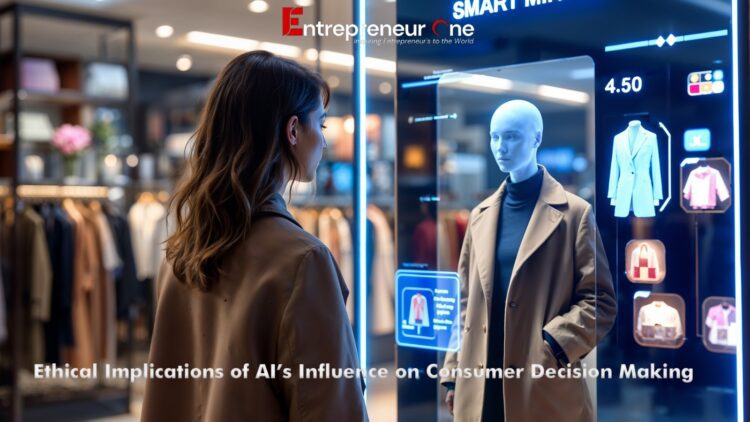The way that we use the internet today makes AI a part of every decision we make. From the shows we choose to watch to the products we consider purchasing, and even the prices we are shown, algorithms are all simultaneously working behind the scenes. Custom recommendations on streaming services, or ads that seem to know “what you want,” are an everyday reality now.
Take, for example, Netflix. You may have opened it with the intention of just clicking on something random, but when you land on the homepage, you are already presented with a site that is slightly customized for you. Or take Amazon. There, the prices are fluid and based on what you’ve viewed previously; recommendations evolve based on what you’ve looked at before. This is convenient, but it begs the question of how much control we have.

And this is where ethics come into play. If AI is creating an influence, it is important that users always have an understanding of how – and why. Is the company being transparent, is the company being respectful of privacy, is the company being ethical in respect to groups? This trend touches all facet including digital marketing. If you’re taking the best SEO course, while it might help you stand out, it’s not something we can ignore anymore, and it’s worth understanding how AI will influence things, along with the ethical boundaries that come along with it.
How AI Shapes Consumer Decisions

The way apps and websites recommend something that you should watch, listen to, or purchase is not done randomly. The apps and websites look forward using data that they accumulate from your actions, what you have clicked on, how long did you watch a show, and what songs you kept playing. The next step is they would identify gaps in the evidence and from there formulate a prediction about what you would want in the next steps. It is not magic, it is really just a way of being able to identify your preferences for what you like and to follow up on your transactional pathways.
Example: Netflix
Netflix keeps tabs on what you have viewed and how you interact with the content it offers. It tracks how much time you spend watching a show or movie, seldom-viewed scenes or moments that you skipped over, and genres you have returned to multiple times. It then uses that information to recommend new shows or movies that they are guessing you may enjoy. This behavior somewhat shapes your decisions over time by manipulating your thinking to go toward a specific type of content that you may not have pursued in the past.
Example: Spotify
Spotify listens to your behaviors and listening habits. They can see what artists you like and genres you listen to and even the times you listen to music. Based on this, they create playlists for you that meet your need based on the given situation. And these curated playlists help you discover music but they also intentionally shape your behaviour by letting you hear new songs and artists that align with your listening preferences.
Although being offered these personalization recommendations provides convenience and additional enjoyment in their use of apps, they do “nudge” us toward specific features and decisions, or even multiple decisions. A helpful personalized recommendation process may simply be leading you toward a fast conclusion without permission, making it imperative to understand how AI works.
Source: https://engineering.atspotify.com/
Ethical Concerns: Transparency and Manipulation
Artificial intelligence has become very much a part of consumer choice, often without users realizing it. User data from prior searches, purchases, and interactions is being collected, and used to create an ‘experience’ of personalized options. While it is great when brands make suggestions that feel tailored for users, it can be deeply troubling as to how much control consumers will ultimately end up having over their choices.
One of the most obvious examples of this is Facebook, now Meta, which uses user data to help businesses target advertising. Facebook may be described as initially acting ethically by allowing controlled targeting for advertisers, but the average consumer does not understand how much of their personal tracking log they are accessing, and how it may change their preferences and ultimately making choices. This controlled environment ultimately accesses choices are obscured in long-winded generic privacy policies the user must inadvertently attest too.
In addition to transparency, we can also see that several platforms use manipulative forms of persuasion. Examples include representations of scarcity through such labels as, “Last one available!” or “Offer available for a limited time!” These examples use compression to force the consumer to respond quickly. Additionally, sometimes recommendations may highlight unseen biases that influence choices without any rationale. These actions take advantage of human psychology, not provide us with best options.
When ethical lines are blurred it begs the question: is it okay to influence consumer behavior if it enhances their experience or is it a problem when it serves to manipulate people to make decisions they were not necessarily going to make? This is precisely why we need a greater adherence to best practices and responsible AI usage in consumer behavior.
Data Privacy and Consent
Artificial Intelligence depends on vast amounts of data that can be collected, analyzed, and profiled, and it doesn’t require an “opt in” mindset for these profiled users. Every click, search, and location detail creates more data. Information is collected and then analyzed to create a profile of users which can then be used to offer a suggestion, serve an ad, or modify a service based on our personal habits.
The broader concern, however, is whether users truly understand how their data is used. Consent descriptions are typically buried in long terms and privacy policies. They simply select “agree” without further thought, at this point, most either don’t engage or fully understand how much data was being gathered or the purposes of its gathering. This creates dissonance with what the individual user believes they are consenting to, between a sense of participating or not left guessing how much of a personal identity is shared.
As long as the volume of data collection grows, that dissonance begins to create more serious issues. Users will have no idea of the different ways their habits are constantly tracked and shaped as long as there is a lack of transparency, or a lack of a decision made by a user to intentionally provide their data. The notion of privacy and consent are serious and troubling questions.
Source: https://policies.google.com/privacy
Bias in AI and Its Effects on Decision Making
AI systems are only as good as the data they are trained on, therefore, if the data is biased or not representative of a variety of perspectives, then the AI’s results will always be biased and will always have an unfair perspective. Consider Amazon’s recruitment tool, which preferred male over female candidates simply because it was trained on historical hiring data, this unintended bias has the potential to reinforce stereotypes and lead to discriminatory outcomes.
The same kinds of biases can also emerge in systems that target consumers. Recommendations for products or services may specifically privilege some groups while excluding others, steering peoples’ choices and limiting access to choice without justification. These unintended biases can be very easy to miss; however, the impact can be very real.
To mitigate this, there needs to be assurance that data sets are diverse and representative. Regular auditing and regular checking give full assurance that there will be no bias creeping into the system that may, in some instances, create unfair treatment, either deliberately or unintentionally, or create manipulation that has too much power.
Source: https://www.reuters.com/article/us-amazon-com-jobs-automation-insight-idUSKCN1MK08G/
Psychological and Social Impact
The implications of AI extend beyond merely affecting what people purchase; it also affects how they behave. For example, online shopping services frequently display personalized suggestions for “other items you might want” to prompt more purchases, which often lead users toward impulsive purchases that support existing patterns of compulsive spending. Over time, patterns of buying can lead to feelings of anxiety or other negative habits, particularly if the individual perceives there is a need to keep up or act quickly in any way.
The line between being helpful and exploiting vulnerabilities is a thin one. While personalized approaches help make purchases easier, they can capitalize on a person’s emotional or anxiety-driven responses. There are responsibilities for brands to use their tools in a way that prioritizes consumer wellbeing, as opposed to simply wanting to profit from minimizing the consequences of distressing consumer factors that can lead to poor mental health and financial stability.
Conclusion
The increasing integration of AI within consumer decision making impacts users and brands alike. For consumers, it is vital to understand how organizations house and utilize their data, while brands must assume responsibility for how their tech systems exhibit influence on the behavior of consumers. A meaningful and ethically-sound use of AI requires accountability, transparency, and fairness in every step, not just for consumers but for everybody. Beyond rules and guidelines, ethical behavior fosters trust and alignment between companies and their customers.
Brands that focus on responsible AI design will strengthen their relationship to their users. By having clear communication and diverse, unbiased data sets, we can build a system where recommendation algorithms serve to support consumers rather than manipulating them. As both technologies become more sophisticated, it will be even more important for practitioners to learn from a top digital marketing course in Mumbai on how to leverage AI responsibly, considering the importance of accountability and the impact on user trust and choice.
Author Bio:
Nikita is a digital marketing professional at BIA and an MBA graduate in Marketing. With a passion for emerging industry trends, she enjoys crafting strategies that resonate and unwinds by diving into fiction novels during her downtime.
















